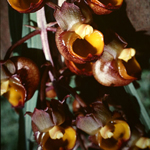
 |
|
Most Common Orchids
Other Links
|
| Home | | | Anguloa | | | Cattleya | | | Cymbidium | | | Oncidium | | | Epidendrum | | | Catasetum | | | Miltonia | | |
|
Catasetum
Catasetums are popular for their unique dimorphic flowers. The male & female flowers are morphologically different. It also shows most advanced pollination mechanism. Bees are mainly responsible for pollination. Male flowers start to emit strong musky odour 2-3 days after opening where male bees are attracted and they enter the flower & start to scratch at source of the odour, which is normally directly beneath the antennae at the base of column. At the same viscidium is released and is thrown on the back of the bee. By the time bee enter a female flower, since flowers of two sexes of some species are significantly different.
General Conditions : The plants produce fattened, fleshy pseudo bulbs and are deciduous. The plant requires year round warm house conditions with good air circulation.
Temperature : Usually plant is grown at 75˚-80˚F during day and 60˚-70˚F at night.
Light : The growth of the plant is most vigorous under brighter condition & heavier bulbs produced are capable of yielding more substantial inflorescences of better quality blooms. Female flowers are produced in bright light and as plant complete the flowering cycle it require less light.
Potting media, Containers, Water, and Fertilizer Catasetum must be planted in well-drained medium. Repotting should ideally be done during spring when plants are making growth. Watering may become more regular & heavier as growth increases.
Fertilizer must be using preferably 20-20-20 at the rate of one teaspoon gallon of water applied as once a week. Grow more fertilizer have micronutrients, which provide strength for new growth & support for the flowers. Plants need not be unspotted and dried out after flowering.
Spider mite infestation is more susceptible in Catasetum. Miticide can be used at the recommended dilution. If rot should develop in Catasetum bulbs cut away the affected area or bulb treating the cut surface with captan dithane M45 or banrot paste and should not be watered until problem is cured.
